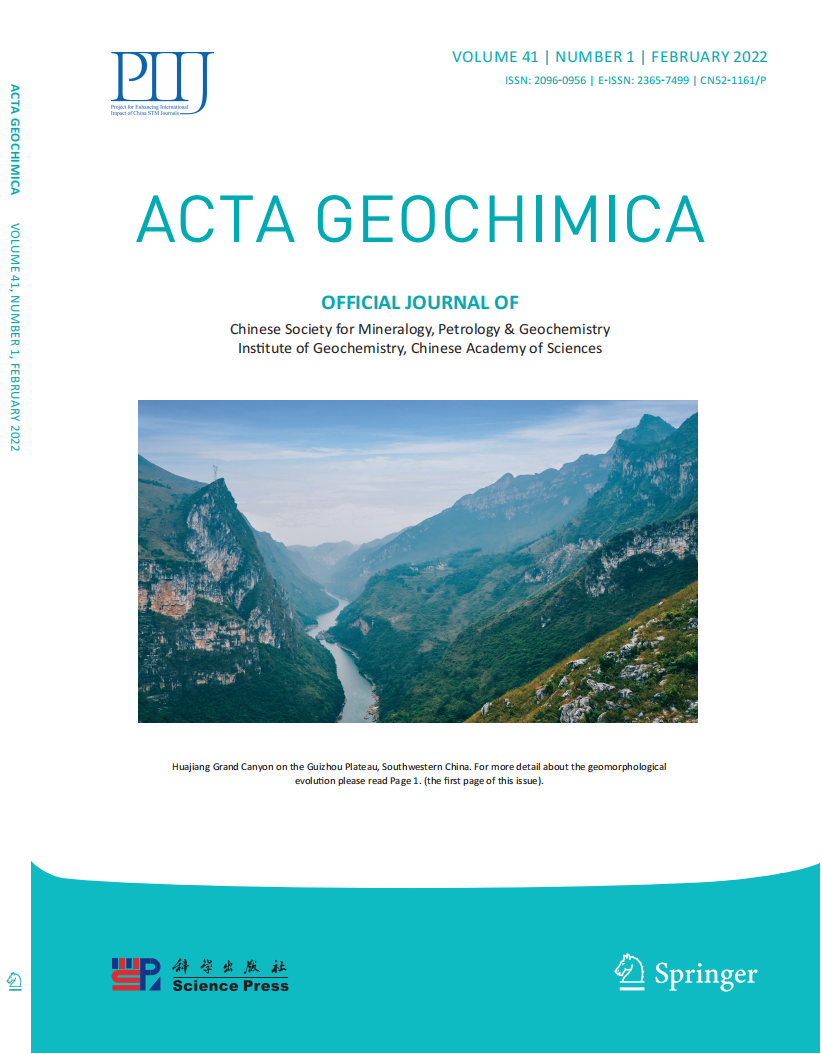- 钛学术文献服务平台 \
- 学术期刊 \
- 基础科学期刊 \
- 化学期刊 \
- 地球化学学报(英文)期刊 \
Using trace elements of magnetite to constrain the origin of the Pingchuan hydrothermal low-Ti magne
Using trace elements of magnetite to constrain the origin of the Pingchuan hydrothermal low-Ti magne
原文服务方:
地球化学学报(英文)
摘要:
The Pingchuan iron deposit, located in the Yanyuan region of Sichuan Province, SW China, has an ore reserve of 40 Mt with ~ 60 wt% Fe. Its genesis is still poorly understood. The Pingchuan iron deposit has a paragenetic sequence of an early Fe-oxide–Pyrite stage (Ⅰ) and a late Fe-oxide–pyrrhotite stage (Ⅱ). Stage Ⅰ magnetite grains are generally fragmented, euhedral–subhedral, largesized crystals accompanying with slightly postdated pyrite. Stage Ⅱ magnetite grains are mostly unfragmented, anhedral, relatively small-sized grains that co-exist with pyrrhotite. Combined with micro-textural features and previously-obtained geochronological data, we consider that these two stages of iron mineralization in the Pingchuan deposit correspond to the Permian ELIP magmatism and Cenozoic fault activity event. Both the Stage Ⅰ and Ⅱ magnetites are characterized with overall lower contents of trace elements (including Cr, Ti, V, and Ni) than the ELIP magmatic magnetite, which suggests a hydrothermal origin for them. "Skarn-like" enrichment in Sn, Mn, and Zn in the Stage Ⅰ magnetite grains indicate significant material contributions from carbonate wall-rocks due to water–rock interaction in ore-forming processes. Stage Ⅱ magnetite grains contain higher Mn concentrations than Stage Ⅰ magnetite grains, which possibly implies more contribution from carbonate rocks. In multiple-element diagrams, the Stage I magnetite shows systematic similarities to Kirunatype magnetite rather than those from other types of deposits. Combined with geological features and previous studies on oxygen isotopes, we conclude that hydrothermal fluids have played a key role in the generation of the Pingchuan low-Ti iron deposit.

推荐文章
Trace element composition of magnetite from the Xinqiao Fe–S(–Cu–Au) deposit, Tongling, Eastern Chin
Xinqiao
Skarn
Magnetite
In-situ analysis
Tongling
Distribution and geochemical significance of trace elements in shale rocks and their residual keroge
Shale
Kerogen
Trace elements
REEs
Variations of trace elements under hydrological conditions in the Min River, Eastern Tibetan Plateau
Trace elements
Concentration-discharge relationship
Tibetan Plateau
River
Rare-earth and trace elements and hydrogen and oxygen isotopic compositions of Cretaceous kaolinitic
Rare-earth and trace elements
Oxygen/hydrogen isotopic composition
Kaolinitic sediments
Lower Benue Trough
Nigeria
内容分析
关键词云
关键词热度
相关文献总数
(/次)
(/年)
文献信息
| 篇名 | Using trace elements of magnetite to constrain the origin of the Pingchuan hydrothermal low-Ti magne | ||
| 来源期刊 | 地球化学学报(英文) | 学科 | |
| 关键词 | SW China Pingchuan iron deposit Low-Ti iron deposit Hydrothermal magnetite | ||
| 年,卷(期) | 2019,(3) | 所属期刊栏目 | |
| 研究方向 | 页码范围 | 376-390 | |
| 页数 | 14页 | 分类号 | |
| 字数 | 语种 | 英文 | |
| DOI | 10.1007/s11631-019-00332-2 | ||
五维指标
版权信息
全文
- 全文.pdf
引文网络
引文网络
二级参考文献 (0)
共引文献 (0)
参考文献 (0)
节点文献
引证文献 (0)
同被引文献 (0)
二级引证文献 (0)
2022(0)
- 参考文献(0)
- 二级参考文献(0)
- 引证文献(0)
- 二级引证文献(0)
研究主题发展历程
节点文献
SW China
Pingchuan iron deposit
Low-Ti iron deposit
Hydrothermal magnetite
研究起点
研究来源
研究分支
研究去脉
引文网络交叉学科
相关学者/机构
期刊影响力
地球化学学报(英文)
主办单位:
中国科学院地球化学研究所
出版周期:
双月刊
ISSN:
2096-0956
CN:
52-1161/P
开本:
大16开
出版地:
贵州省贵阳市观水路46号地球化学研究所
邮发代号:
创刊时间:
1982-01-03
语种:
英文
出版文献量(篇)
294
总下载数(次)
0
期刊文献
相关文献
推荐文献

 免费查重
免费查重










